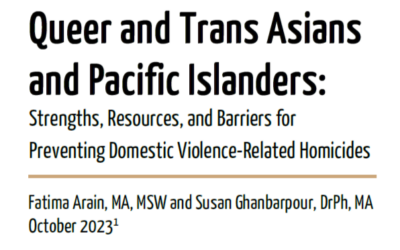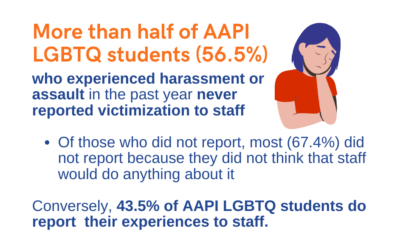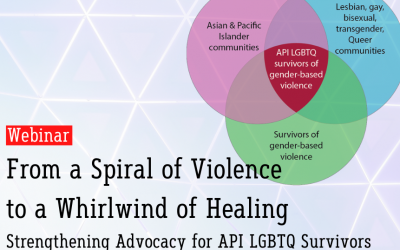LGBTQ Intimate Partner Violence
For examples of terms related to gender identity and sexual orientation, such as intersex, genderqueer, and nonbinary, see PFLAG’s National Glossary of Terms.
Queer and Trans Asians and Pacific Islanders:
Strengths, Resources, and Barriers for Preventing Domestic Violence-Related Homicides
This report presents a groundbreaking qualitative research project focusing on the prevention of domestic violence-related homicides among queer and trans Asians and Pacific Islanders (QTAPI). It uncovers the complex web of risk factors, including isolation and...
API LGBTQ Demographic Estimates based on 2010 Data
- 3% (approximately 325,000) of the adult Asian and Pacific Islander population in the U.S. identifies as LGBT.
- There are approximately 33,000 API same-sex couples in the U.S.
- U.S. LGBT API adults tend to live in areas where there are higher proportions of API individuals, as opposed to areas with higher proportions of the broader LGBT population. About one third of API same-sex couples live in California, Hawai’i and New York.
- 26% of API same-sex couples in the U.S. are raising children.
Williams Institute: LGBT Asian and Pacific Islander Individuals and Same Sex Couples (2013)
The Primary Aggressor Assessment Tool (consisting of instructions and worksheets) was developed by the Northwest Network to help advocates determine whether there is a pattern of power, control and exploitation within a relationship, and which partner is establishing systematic power and control.
LGBTQ Intimate partner Violence
The CDC’s 2010 national study found that lesbian, gay and bisexual people experience intimate partner and sexual violence at the same or higher rates as heterosexual people, although bisexual women experienced violence at overall higher rates:
- 44% of lesbian women and 61% of bisexual women (compared to 35% of heterosexual women) experienced rape, physical violence, and/or stalking by an intimate partner in their lifetime.
- 26% of gay men and 37% of bisexual men (compared to 29% of heterosexual men) experienced rape, physical violence, and/or stalking by an intimate partner in their lifetime.
CDC: NISVS 2010 Findings on Victimization by Sexual Orientation (Released 2013)
In NCAVP’s 2015 report, bisexual women and gay men reported intimate partner violence perpetrators as primarily male, while lesbians and bisexual men reported intimate partner violence perpetrators as primarily female.
- 43% of survivors identified as gay, 19% identified as lesbian, 16% identified as heterosexual, 10% identified as bisexual, and 9% identified as queer.
- 64% of survivors were between 19 and 39 years old.
- The most common types of violence reported were physical violence (20%), verbal harassment (18%), and threats and intimidation (13%).
- Survivors younger than 24 were three times more likely to report experiencing sexual violence than survivors 25 years old or older.
NCAVP: LGBTQ and HIV-Affected Intimate Partner Violence in 2015 (Released 2016)
Resources
AAPI LGBTQ+ Experiences of GBV
This factsheet summarizes the layered needs and experiences of lesbian, gay, bisexual, transgender, queer, and more (LGBTQ+) Asian, Asian American, and Pacific Islander (AAPI) survivors and communities in the U.S., based on the current literature available. Although...
Gender-Based Violence in Asian, Middle Eastern, Native Hawaiian and Pacific Islander LGBTQ Communities: Roundtable Report
This report summarizes and synthesizes discussion from a roundtable on GBV in Asian, Middle Eastern, Native Hawaiian, and Pacific Islander LGBTQ communities, convened by API-GBV in September 2019. Attendees discussed how gender manifests as a site of oppression for API LGBTQ individuals, and strategies to address violence in API LGBTQ communities.
From a Spiral of Violence to a Whirlwind of Healing: Strengthening Advocacy for API LGBTQ Survivors
Domestic violence and intimate partner abuse have often been understood in terms of men’s violence against women. However, lesbian, gay, bisexual, transgender and queer-identified individuals consistently experience intimate partner violence at similar rates as heterosexual women. With 21-55% of Asian women reporting experiences of intimate physical and/or sexual violence during their lifetime, the implications for LGBTQ API individuals are extensive. Yet while the number of anti-violence programs serving Asian and Pacific Islander communities has grown considerably over the last decades, there is little research and still very few culturally-specific resources for LGBTQ survivors of gender-based violence.
This webinar will offer a framework for understanding Asian and Pacific Islander LGBTQ experiences of gender-based violence, and the multiple barriers that these survivors face when seeking support. Integrating highlights from the Institute’s September 2019 Roundtable on API LGBTQ communities, this presentation will provide ideas and recommendations for organizations to engage and serve API LGBTQ survivors more effectively.
Organizing in Asia: A Presentation by Grace Poore, OutRight Action International
This report summarizes a presentation by Grace Poore, Regional Program Coordinator for Asia and the Pacific Islands at Outright Action International. The presentation and following Q&A set the context of struggles and activism for LGBT rights in Asian countries, and includes critical analysis, research, discussions among activists, backlash and its impacts, societal contexts, and movement strategies infusing the work for LGBT rights and safety in Asia.
Resources on LBGTQ Intimate Partner Violence
National LGBTQ Institute on IPV: builds collaborations across LGBTQ anti-violence and domestic violence fields, increasing public awareness and enhancing state, local, and national efforts to prevent and address LGBTQ intimate partner violence.
- Creating the Conditions for Change: A Blueprint for Increasing LGBTQ Access to DV Advocacy (2016)
- There’s No One I Can Trust: The Impact of Mandatory Reporting on the Help-Seeking and Wellbeing of Domestic Violence Survivors (2016)
Northwest Network of Bi, Trans, Lesbian and Gay Survivors of Abuse: increases communities’ ability to support the self-determination and safety of LGBT survivors of abuse via education, organizing and advocacy through technical assistance, training, and resources, including twice a month webinars, the Information Clearinghouse on Violence & Abuse in LGBTQ Communities, and a library of advocacy resources
- Primary Aggressor Assessment Tool: overview, instructions, and worksheets
LGBTQ Resources for API Communities
Asian Women’s Shelter: Queer Asian Women and Transgender Support shifts socio-cultural norms from those that justify or allow violent behavior between intimate partners to new norms that promote non-violent, healthy relationships
Brown Boi Project: a community of masculine-of-center womyn, men, two-spirit people, transmen, and allies committed to changing the way that communities of color talk about gender
Community United Against Violence: works to build the power of LGBTQ communities to transform violence and oppression, supports the healing and leadership of those impacted by abuse, mobilizes communities to replace cycles of trauma with cycles of safety and liberation, and works to create truly safe communities where everyone can thrive
Hmong Queer Suab: a grassroots Hmong LGBT community that provides advocacy and safe space to connect and share experiences.
Human Rights Campaign Foundation: Coming Home to Islam and to Self (2015): a guide aimed at LGBTQ American Muslims who are on the journey toward living fully in their sexual orientation, gender identity and expression, and in their faith and its traditions
National Queer Asian Pacific Islander Alliance: a federation of LGBT API organizations seeking to build the organizational capacity of LGBT API groups, develop leadership, promote visibility, educate communities, enhance grassroots organizing, expand collaborations, and challenge homophobia and racism
- Queer Asian Compass: A Descriptive Directory of LGBTQ AAPI Organizations (2013)
- Asian Parents who Love their LGBT Kids (2015): a series of short videos featuring API parents expressing love for their LGBT children in Mandarin, Cantonese, Hindi, Korean, Japanese, Vietnamese, Lao, Tagalog, and English
- Family is Still Family, Love is Love: one page factsheets for API parents who have LGBTQ children that answer basic questions about being LGBTQ and dispel common misperceptions — in Arabic, Bengali, Chinese (simplified and traditional), Korean, Japanese, Indonesian, Gujarati, Hindi, Hmong, Ilocano, Indonesian, Khmer, Lao, Punjabi, Tagalog, Thai, Urdu, Vietnamese
South Asian Network: No More Denial! Giving Visibility to the Needs of the South Asian LGBTIQ Community in Southern California (2010)
TongYu: Chinese LGBTI+ Students’ School Environment Research Report (2016)
United Nations Development Programme (UNDP): Lost in Transition: Transgender People, Rights and HIV Vulnerability in the Asia-Pacific Region (2012)
Related Articles
Other Resources
National Coalition of Anti-Violence Programs: empowers LGBTQ and HIV-affected communities and allies to end all forms of violence through organizing and education, and supports survivors through counseling and advocacy
- Training and Technical Assistance Center on LGBTQ Cultural Competency
- From Policy to Practice: Nondiscrimination and Inclusion of LGBTQ Individuals in Victim Services Programs (2017)
- 2015 Report on LGBTQ and HIV-affected Intimate Partner Violence
National Council on Elder Abuse: Mistreatment of Lesbian, Gay, Bisexual, and Transgender Elders (2013) research brief synthesizes the latest available information and research on the occurrence of abuse, isolation as a risk factor, issues affecting help-seeking, and tips for working with LGBT elders
National LGBTQ Institute on IPV: builds collaborations across LGBTQ anti-violence and domestic violence fields, increasing public awareness and enhancing state, local, and national efforts to prevent and address LGBTQ intimate partner violence.
- Creating the Conditions for Change: A Blueprint for Increasing LGBTQ Access to DV Advocacy (2016)
- There’s No One I Can Trust: The Impact of Mandatory Reporting on the Help-Seeking and Wellbeing of Domestic Violence Survivors (2016)
Northwest network of Bi, Trans, Lesbian and Gay Survivors of Abuse: increases communities’ ability to support the self-determination and safety of LGBT survivors of abuse via education, organizing and advocacy through technical assistance, training, and resources, including twice a month webinars, the Information Clearinghouse on Violence & Abuse in LGBTQ Communities, and a library of advocacy resources
- Primary Aggressor Assessment Tool: overview, instructions, and worksheets
PFLAG: National Glossary of Terms on gender identity and sexual orientation
United Nations Development Programme: Lost in Transition: Transgender People, Rights and HIV Vulnerability in the Asia-Pacific Region (2012)
Williams Institute: Intimate Partner Violence and Sexual Abuse among LGBT People: A Review of Existing Research (2015)


